‘SPEAKING WITH LIGHT’ Denver Art Museum highlights the narrative of Indigenous people P4




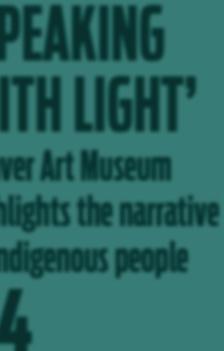
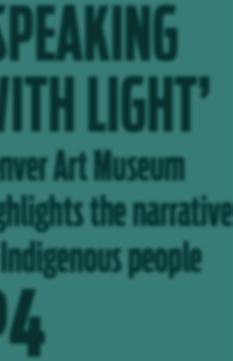
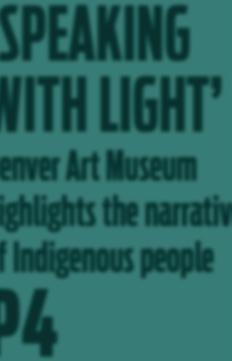
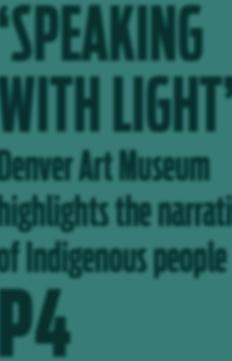


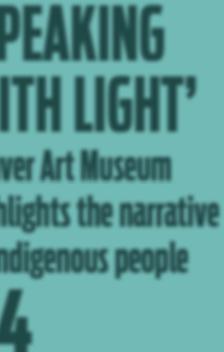
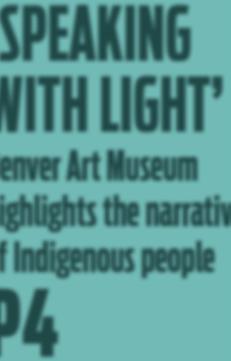

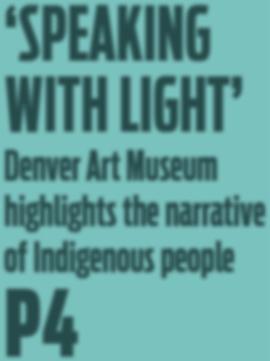

‘SPEAKING WITH LIGHT’ Denver Art Museum highlights the narrative of Indigenous people P4

















Natalia Roberts brings her multiple talents to Art Students League of Denver

THE JOY OF MUSIC Annual instrument drive runs through March 19 P14

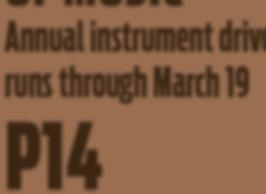




ARE AROUND THE CORNER



What you need to know to cast your ballot


P6


Alpine Dog Brewing Company
In late January, Alpine Dog Brewing Company opened at 1308 E. 17th Ave. in Denver’s City Park West neighborhood.

is is a reopening that had been in the works since August 2021 when the brewery closed its Ogden Street location in Uptown. According to Westword reporting, the brewery opened there in 2014.
e brewery currently has a selection of ve craft beers, hard seltzers and a few non-alcoholic beverages.
To learn more, visit alpinedogbrewery.com. Photo courtesy of Alpine Dog Brewing Company’s Facebook.
A new store to purchase vinyl, cassettes, comics, toys, and other vintage nds and collectibles has opened in Denver’s City Park West neighborhood.
Located at 1331 E. Colfax Ave., City Records Comics & Toys opened on Feb. 7. Its business partners are Justin “Doctah Jay” Gnazzo, Seekay Gnazzo and Troy “Tbone” Bolton.
“We are so excited to join the Colfax neighborhood,” Seekay Gnazzo wrote in an email. “City Records intends on creating a safe space for people in the community to connect over a shared love of nostalgia. We also proudly support local artists and musicians with products for sale throughout the store. We look forward to being a part of this community for years to come.”
To learn more about the store, visit cityrecordscolfax.com.
Colfax Ave BID originally reported on the store’s opening.
City Records Comics & Toys owners, from left, Justin “Doctah Jay” Gnazzo, Seekay Gnazzo and Troy “Tbone” Bolton. Courtesy photo.

Chocolate Lab Chocolate Lab, a chocolatecentric shop and restaurant, has reopened in Denver’s Hilltop neighborhood.
e restaurant specializes in incorporating chocolate “into every dish and cocktail as
either the star or supporting role,” states its website.








Chocolate Lab was formerly located on East Colfax Avenue in Denver’s Congress Park neighborhood, where it had served customers since 2016. e business launched in 2010, according to Westword.
Chocolate Lab is now located at 5575 E. 3rd Ave. To learn more, visit chocolatelabdenver.com.
Bad Habits Bad Habits, 3014 E. Colfax Ave. in Denver’s Congress Park neighborhood, had its soft opening recently.
It is an LGBTQIA+ all-inclusive bar and eatery serving patrons 21+.
Bad Habits o ers a menu of bar eats, ranging from fried food favorites, pizza bread, quesadillas and wings, in addition to its fully-stocked bar and mocktails. It also hosts a variety of events and entertainment. According to gaydenver.com, Bad Habits’ grand opening event will take place on March 11 with a luau party including live Polynesian dancers.
To learn more about Bad Habits, visit badhabitsdenver.com.

Logo courtesy of Bad Habits’ Facebook page.
Aaron Forman Westword reported that on Feb. 10, Aaron Forman, the longtime owner of the Table 6 restaurant, died.

Table 6, located at 609 Corona St. in Denver’s Speer neighborhood, got its start about 20 years
ago. It is an American bistro that o ers seasonal menus with a focus on fresh, farm-to-table ingredients.
A memorial fundraiser to bene t the Food Bank of the Rockies has been created in Forman’s honor. To donate, visit ignite. foodbankrockies.org/fundraiser/4452072.
Table 6 remains open. To learn more or make a reservation, visit table6denver.com.
Photo courtesy of Table 6’s website.
Colorado Business Hall of Fame
e 34th Colorado Business Hall of Fame inductees event took place on Feb. 6.
e annual event, hosted by Junior Achievement-Rocky Mountain, Inc. and the Denver Metro Chamber of Commerce, honors Colorado’s most distinguished and in uential business leaders. Inductees are recognized for their professional accomplishments and long-term impact on the state’s economy and their philanthropic contributions to the community.
In February, Ascent Living Communities’ Hilltop Reserve, 525 S. Holly St., celebrated its one-year anniversary of opening in Denver’s Washington Virginia Vale neighborhood.
Ascent Living Communities is a Colorado-based senior living owner and operator founded by Colorado’s Tom and Susie Finley.
To learn more about Ascent Living Communities’ Hilltop Reserve, visit hilltopreserve. com.
Logo courtesy of the Ascent Living Communities website.








is year, ve people were inducted, representing a variety of industries that include computer consulting and programming, real estate and architectural development, oil and gas, and mutual fund management. e 2023 inductees are Bill Berger, Mary Pat Link, Jay Precourt, Frederick Ross and Mark Smith.
To learn more about the Colorado Business Hall of Fame, visit coloradobusinesshallo ame.org.
Junior Achievement-Rocky Mountain and the Denver Metro Chamber of Commerce hosted the 34th Colorado Business Hall of Fame inductees event on Feb. 6. Photo courtesy of Junior Achievement-Rocky Mountain’s 2023 Colorado Business Hall of Fame.
Youth Healthcare Alliance
Pete’s Central One
Pete’s Central One, 300 S. Pearl St., celebrated its 25th anniversary in February. is restaurant, located in Denver’s West Washington Park neighborhood, o ers Greek cuisine and is one of the family-owned Pete’s Restaurants.

Pete’s Restaurants got their start by the late Pete Contos back in 1962 when he opened Pete’s Satire Lounge, 1920 E. Colfax Ave. in Cheesman Park. Next to come was Pete’s Kitchen, 1962 E. Colfax Ave., also in Cheesman Park, which opened December of 1988. Pete’s University Park Café, 2345 E. Evans Ave., opened in 1996, and Pete’s Central One opened February of 1998.
To learn more about the restaurants, visit www. petesrestaurants.com.
Photo courtesy of Pete’s Central One’s website.
Youth Healthcare Alliance, formerly known as the Colorado Association for

School-Based Health Care, recently announced its new name and rebrand. e organization is a nonpro t membership association that provides essential resources, guidance, and services to school-based clinics in Colorado. It got its start about 25 years ago. Today, it supports Colorado’s 70 school-based clinics which provide services to 44 high schools, 23 middle schools, 22 elementary schools and eight early childhood centers across the state.
A news release states that “school-based clinics exist to decrease barriers to healthcare. By supporting comprehensive health needs, they complement the mission of schools, as they are focused on supporting youth in reaching their potential, and in doing so, they allow educators one more resource for students, which increases the ability to focus on education in the classroom.”
To learn more about the Youth Healthcare Alliance, visit youthhealthcarealliance.org.
Logo courtesy of the Youth Healthcare Alliance website.

Metro Water Recovery received a National Environmental Achievement Award from the National Association of Clean Water Agencies during a February conference in Sonoma, California.
Metro Water Recovery is a resource recovery and clean water agency in the Rocky Mountain West that formed under Colorado law in 1961. It has partnerships with 61 local governments including cities, counties and sanitation districts, and serves about 2.2 million people in an 805 square-mile area.

Metro Water Recovery received the award for its South Platte River Aquatic Life/Habitat Improvements Project. e main goal of this six-phase project is to increase dissolved oxygen levels and improve aquatic life habitat for native sh communities. Phase V will be initiated this year, and it will entail an array of work including a biological survey, construction, monitoring water quality and a sh survey to be done annually into the future.
To learn more, visit metrowaterrecovery. com
Jordan Parman, senior water quality scientist for Metro Water Recovery, conducts a sh survey in the South Platte River. Photo courtesy of Metro Water Recovery.

OVME


OVME, a medical aesthetic enterprise, has opened in Denver’s Cherry Creek North.





Pronounced “of me,” OVME delivers “curated medical aesthetic experiences in contemporary and welcoming environments,” states its website.
ere are many OVME locations across the eastern U.S., and the Cherry Creek North location is its rst Colorado location as well as its furthest west location. It is located at 180 Clavton Lane.
To learn more about OVME, visit ovme.com.



Photo courtesy of OVME’s website.

Last month’s story about Maj. Gen. Maurice Rose incorrectly stated the cost of the statue.
 BY CHANCY J. GATLIN-ANDERSON SPECIAL TO COLORADO COMMUNITY MEDIA
BY CHANCY J. GATLIN-ANDERSON SPECIAL TO COLORADO COMMUNITY MEDIA
In 1977, writer and philosopher Susan Sontag said in her book, “On Photography,” that “to photograph people is to violate them, by seeing them as they never see themselves, by having knowledge of them that they can never have; it turns people into objects that can be symbolically possessed.”
Photography can tell a thousand stories. roughout the past several decades, visual anthropologists have studied Sontag’s work along with that of other writers, researchers and philosophers. Some anthropologists argue that the purest form of photography is that which is captured by the individual, documenting their own life and shining a light on selfhood, human behavior and even deep, personal struggle.
At the Denver Art Museum’s newest photography exhibition entitled “Speaking with Light: Contemporary Indigenous photography,” more than 30 Native photographers have come together to tell their own personal stories of struggle, erasure, anger and stereotyping. ey’ve also visually depicted their stories of humor, joy, perseverance and the Native spirit.
“As an exhibition, one of the aims of the artists is to reclaim and takeback the narrative about Indigenous people in North America. It is people who are given a voice and an opportunity to make pictures that address a lot of historical issues about stereotyping, invisibility, poverty and violence. But it isn’t all about that,” said Eric Paddock, curator of photography at the Denver Art Museum. “It isn’t all about blame or throwing the darker parts of our history into high relief. It does that, but there are also pictures that express the importance of family, and of community, and the value of memory in the everyday lives of Indigenous people. In those respects. ey’re not that di erent from the needs and hopes of other people.”
“Speaking with Light” is one of the rst major museum surveys to explore the practices of Indigenous photographers working over the past three decades. e exhibition was organized by the Amon Carter Museum of Art in Fort Worth, Texas, where it debuted before its presentation in Denver. It includes new commissions and recently acquired works from the Amon Carter Museum’s collection alongside loans from artists and other institutions.
e colorfully curated exhibit is divided into four sections. e exhibit takes visitors on a journey of the Native experience, beginning with depictions of Native people taken by White photographers, and ending with a story of resilience.
e rst section entitled Prologue: State to State features photographs made by White photographers when Indigenous leaders trav-



eled to Washington, D.C. for treaty negotiations. ose leaders may not have been happy about what they heard from the U.S. government, but they projected strength, agency and dignity in the photography studios. Indigenous photographer Will Wilson’s “Talking Tintype” portrait of Enoch Haney, former principal chief of the Seminole Nation of Oklahoma, vividly carries these early photographic encounters into the present day, tracing a through line to questions of identity, governance and sovereignty in the 21st century.
In the second section entitled Survivance: An Ongoing Process, Native photographers use humor, pathos, anger and declaration to defy erasure and stereotyping, and to demand recognition of Indigenous existence, rights and cultural commitment.
Section three is called Nation. In this section, photographs depict the relations Native individuals have
means to belong and question how dislocation, forced assimilation or disconnection impact the concept of nationality.
Indigenous Visualities is the title of section four. It depicts photographs that lift Indigenous voices, embracing spirit and a deep connection with the natural world. e works push back against colonial narratives to demonstrate that Indigenous voices are integral in the ever-evolving social landscape.

“Speaking withLight” concludes with an interactive touchscreen

database, Indigenous Photograph. roughout the exhibition, visitors will encounter short videos and hear insights about the work from artists themselves.
“ is is a pretty special thing that doesn’t come along every day,” said Paddock. “ e people of Denver should come see this exhibition because it shows that there is a huge realm of photography that isn’t on everyone’s radar, that we haven’t been seeing in museums, or reading about in the art press until very recently.”




You might notice that we have taken a short hiatus from our City Council members’ columns. at’s because elections are around the corner and we didn’t want to give any candidates an unfair edge.
Instead, what you’ll notice this month are candidate responses to our questions on our Life on Capitol Hill (lifeoncaphill. com) and Washington Park Pro le (washparkpro le. com) websites.

Our papers span several council districts with races. ese districts are:


• District 4 (Tony Pigford and Diana Romero Campbell)
• District 5 (Amanda Sawyer and Michael Hughes)
• District 6 (Paul Kashmann, incumbent, unopposed)
• District 7 (Nick Campion, Flor Alvidrez, Adam Estro , Arthur May and Guy Padgett)
• District 9 (Candi CdeBaca, Kwon Atlas and Darrell Watson)
• District 10 (Margie Morris, Shannon Ho man, Chris Hinds and Noah Kaplan).
We also are including the nine candidates running for the two AtLarge seats: Travis Leiker, Serena Gonzales-Gutierrez, Pen eld Tate, Sarah Parady, Je Walker, Marty Zimmerman, Will Chan, Dominic A. Diaz and Tim Ho man.
After the election, our monthly councilmember column will return.
Our hope is that the op-eds from the candidates help you make an informed decision when you cast your ballot on Election Day in Denver. Now for a voting need-to-know list.
e rst thing to do — particularly for new Denver residents — is to register to vote or check your voter registration and update it if need be. is can be done at: GoVoteColorado.gov.
For this municipal election, the most important date and time to remember is 7 p.m. April 4. is is Election Day, and thus, the last day to vote in this election. All ballots must be returned by or on this day. For those voting in person on Election Day, you must be in line at a polling center to cast a ballot in person no later than 7 p.m.
Ballots will be mailed out the week of March 13, which is also when the 24-hour ballot drop-o boxes open. It is important to note that if you plan on mailing your ballot, the last day you should do so is March 27 so that it arrives on time.
is is also the last day you are able to register to vote to receive a ballot in the mail.
ere are 43 ballot drop o locations listed on the city’s website. It is important to note the days and times the polling centers are open for in-person voting, as it varies through the month of March. e Saturday they are open is April 1. is link will provide you with all the information you need to nd
Denverite has covered the 2023 mayor’s race breathlessly for months. And it’s been fun.
Here’s why: We’ve been blown away by the number of people wanting to run the city. We’ve been entertained (and occasionally ummoxed) by candidates’ antics and obstacles. We’ve been in awe of all the ideas — well, many of them — about how to x this place and help it thrive.
We’ve been fascinated by how this race ts into Denver’s history and future and this weird present we’re in, where the economy is uncertain, the demographics of the city are uncertain and what people want is — well, uncertain.
All of that means there’s a lot to explore.
Here’s what we’ve done so far
We’ve talked to every single candidate running. Here they are listed in the order they’ll appear on your ballot:
• Lisa Calderón
• Trinidad Rodriguez
• Aurelio Martinez
• omas Wolf
• Al Gardner
• Terrance Roberts
• Kwame Spearman
• Renate Behrens
• Chris Hansen
• Mike Johnston
• James Walsh
• Ean omas Tafoya
• Andy Rougeot
• Leslie Herod
• Robert Treta
• Debbie Ortega
• Kelly Brough
We’ve reported on many of the candidates’ platforms as they’ve been released: the good, the bad and the ugly — all in the eye of the beholder, of course.
We’ve produced issue-speci c coverage of candidates who have released plans.
We’ve covered campaign fundraising: Who’s bringing in the most money, who isn’t and why?
We’ve dug into the rollout of the Fair Elections Fund and the issues it’s faced, including a mid-election tweak to the rules. We also looked at what happens to the money if candidates drop out of the race.
We’ve reported on the rst T.V. ad, a website asco, an AI mayor and more.
We’ve covered debates and forums, including one of the rst that took place at the Park Hill Golf Course and the rst Fair Elections Fund debate at Regis University,
LINDA SHAPLEY Publisher lshapley@coloradocommunitymedia.com
MICHAEL DE YOANNA
Editor-in-Chief michael@coloradocommunitymedia.com
CHRISTY STEADMAN
Editor csteadman@coloradocommunitymedia.com
and the second Fair Elections Fund debate at Metro State University.
We’ve explored, in-depth, what the mayor actually does and how much power the position has. And we’ve spoken to four Denver mayors about their takes on the role and what’s needed in it.
Our work is just beginning heading into the April 4 election and an almost inevitable run-o between the top two vote getters.
Is there anything singularly important about this specific race?
Not one thing but many! We’ve spoken to dozens of Denverites in neighborhoods around the city and community organizations, and they’ve told us what’s on their mind and what issues they want the next mayor to x.
Denverites are worried about the city’s a ordability, with housing costs being top of mind for many. Some Denverites are happy about the growth, others are frustrated — and most we’ve spoken to want it better managed.
ey’re concerned about public safety and rising crime, though many also remain focused on accountability for police and nding
LINDSAY NICOLETTI Operations/ Circulation Manager lnicoletti@coloradocommunitymedia.com
ERIN ADDENBROOKE Marketing Consultant eaddenbrooke@coloradocommunitymedia.com



AUDREY BROOKS Business Manager abrooks@coloradocommunitymedia.com
ballot drop o locations and inperson voting centers: tinyurl.com/ WhereToVoteDenver.
I have two more helpful links to make voting go as smoothly as possible.
e rst is a link to an interactive map with the City Council districts. Denver recently went through a redistricting process and the new districts will go into e ect on Election Day. I found this map most helpful: tinyurl.com/CouncilDistrictsDenver. You can plug in your address and it will tell you what district your address is in.
One more link: the sample ballot, which is available as a downloadable PDF on the city’s elections division’s website: tinyurl.com/ SampleBallotDenver2023. In addition to council candidates, there are 17 mayoral candidates, races for city auditor and clerk and recorder, and three ballot questions. e sample ballot is available now, so you can be well-prepared by the time your ballot arrives in the mail. Happy voting, Denver.

We must focus on the programs that garner bipartisan support I’ve been around a long time, but the last couple of years of politics has drained me. I’ve grown tired of the constant ghting, bickering and general feeling of resentment. While politics has never been happy-go-lucky, when I was young it seemed like politicians got things done. I am hoping that over the next few years something will change, and we can get back to working together to make our lives and our country better.
Until then, I think it’s important we focus on the programs and services that garner bipartisan support. One of those programs that has wide bipartisan support, both at the federal and state level, is Medicare Advantage. Providing high-quality, a ordable health care to seniors and people with disabilities should not be a controversial topic, and I’m glad our legislators seem to agree.
e reason for this bipartisan support is that Medicare Advantage has proven itself to be an e ective program, accomplishing its purpose of providing top-quality health care to some of our most vulnerable Americans, while also being a scally responsible program.
I encourage our federal and state representatives to support bipartisan policy, starting with Medicare Advantage.
Sincerely,
Columnists & Guest Commentaries
Pauline Pfundstein, DenverColumnist opinions are not necessarily those of Life in Cap Hill. We welcome letters to the editor. Please include your full name, address and the best number to reach you by telephone.
Email letters to csteadman@coloradocommunitymedia.com
Deadline 5 p.m. on the 20th of each month for the following month’s paper.
alternative means to achieve community safety.
People say they are concerned about homelessness — both the struggles of people living on the streets and the e ects of homelessness on residents across the city as a whole.
Some want better transportation and more investment in recreation centers and homeless shelters. Others are concerned about education funding, wanting more money going to the schools.
People want solutions, and it’s clear that the people of the city understand that the mayor’s seat can try to tackle many of these issues. So is this why Denverite is spending so much time on the race? Exactly.
e mayor is powerful. e role is often described as the strongest elected position in the state.
e mayor sets the budget, makes more than 700 appointments, is the boss of Denver International Airport, the police department, the sheri ’s department, the Department of Public Safety and more than 11,000 city employees.
And assuming City Council isn’t fully opposed to the mayor’s vision — and that is rarely the case, the mayor can shape everything from the design and the economy of the city to the spirit of the place.
e mayor touches most of what we love and hate about Denver.
And mayors stick, because Denver is a city that mostly reelects incumbents. at happened three times for our current mayor, Michael Hancock, for John Hickenlooper (‘til he ran for governor), Wellington Webb and Federico Peña, who decided to leave after two terms.
ere have only been three elected mayors in the 21st century: Webb, Hickenlooper and Hancock. In that time, there have only been two races when there wasn’t an incumbent — until now. is is rare and a big
Colorado Community Media welcomes letters to the editor. Please note the following rules:
• Email your letter to letters@coloradocommunitymedia.com. Do not send via postal mail. Put the words “letter to the editor” in the email subject line.


• Submit your letter by 5 p.m. on Wednesday in order to have it considered for publication in the following week’s newspaper.
• Letters must be no longer than 400 words.
• Letters should be exclusively submitted to Colorado Community Media and should not submitted to other outlets or previously posted on websites or social media. Submitted letters become the property of CCM and should not be republished elsewhere.
• Letters advocating for a political candidate should focus on that candidate’s qualifications for o ce. We cannot publish letters that contain unverified negative information about a candidate’s opponent. Letters advocating for or against a political candidate or ballot issue will not be published within 12 days of an election.
opportunity for whoever’s lucky enough to win over the public.
If somebody wins the o ce and doesn’t quit rst, there’s a good chance the person will hold the role for the next 12 years.
e new administration will shape the city’s future for years to come. Decisions made by mayors a hundred years ago or more shape the city’s present today, and as Hancock told us, mayors carry out each other’s legacies.
So it’s important, even if you’re not following politics blow by blow, to brush up on who’s running, what they believe in and what troubles they may have. After all, we can help pick who leads us.
So what’s Denverite’s approach to covering the race?
We are diving into the candidates’ approaches to the issues readers have told us matter to them. When candidates drop signi cant proposals on these issues, we report about them.
We’ve also focused on candidates who are making waves, either in name recognition through the limited polling we’ve seen or through donations — both quantity of money and the Fair Elections Fund.
And we’re going to keep covering the candidates putting out plans that may a ect you and how you live, play and go about being in this city.
e team at Denverite has many of the same questions you do, and we’re looking for answers. In a crowded election, we want to make sense of it all. And we want the entire city to be informed by clearheaded reporting as voters sit down to decide who to support in the general election and eventually the run-o .
So here’s the deal. We’ll keep covering this race. You keep reading and letting us know what you want from our coverage.
is story is from Denverite, a nonpro t Denver news source a liated with CPR News. Used by permission. For more, and to support Denverite, visit denverite.com.
• Publication of any given letter is at our discretion. Letters are published as space is available.
• We will edit letters for clarity, grammar, punctuation and length and write headlines (titles) for letters at our discretion.
• Please don’t send us more than one letter per month. First priority for publication will be given to writers who have not submitted letters to us recently.
• Submit your letter in a Word document or in the body of an email. No PDFs or Google Docs, please.



• Include your full name, address and phone number. We will publish only your name and city or town of residence, but all of the information requested is needed for us to verify you are who you say you are.
• Letters will be considered only from people living in Colorado Community Media’s circulation area in Adams, Arapahoe, Clear Creek, Denver, Douglas, Elbert, Je erson and Weld counties.
• Do not use all caps, italics or bold text.
• Keep it polite: No name calling or “mudslinging.”
This maze art features a clock in the shape of a columbine — Colorado’s state flower — to represent the spring forward daylight savings time, which will occur on March 12 this year. This maze can be solved by starting at the S at the tip of either of the lower two flower petals and mazing-out to the W for win at 12 o’clock.

Mile High Happenings is a monthly column featuring community events throughout Denver, highlighting events that take place in the central and central-south neighborhoods covered by the Washington Park Pro le and Life on Capitol Hill newspapers.
Event submissions from community members and organizations are welcome. Submissions should include brief details about the event and a photo

Time: Varies.
Location: Multiple.
Cost: Varies.
e Month of Photography is a biennial festival that takes place in March in its respective years to celebrate the art of photography. It was founded by Denver-based artist Mark Sink in 2004. e festival is presented by and headquartered at the Colorado Photographic Arts Center, 1070 Bannock St. in Denver’s Golden Triangle Creative District, which is a nonpro t organization. e 2023 Month of Photography Denver will include a diverse array of photography exhibitions in many spaces — including museums, galleries, universities, community art centers, nonpro t organizations, public spaces and businesses — throughout Denver, the metro area and other Colorado cities. A complete schedule of events and exhibits can be found on the Month of Photography Denver’s website.
More information/reservations: denvermop.org
Logo courtesy of the Month of Photography Denver’s Facebook.

2023
Time: Varies.
Location: Multiple.
Cost: Varies.
Youth On Record’s fth annual Music Matters is taking place throughout the entire month of March. is year, nearly 40 partners have con rmed their participation. How it works is the public visits the various partner businesses and venues, and they donate a portion of their proceeds to Youth on Record. For example, some are donating $.25-$1 from each ticket sale and others are donating a percentage from the sale of a specialty beverage or food item. Youth On Record is a Denver-based nonpro t that designs and implements strengths-based, musiccentered programs intended to equip young people from historically under-resourced communities with the skills needed to nd success in life.
More information/reservations: youthonrecord.org/event/music-matters
Logo courtesy of the Youth On Record website.


March 3-12
or event logo.

Deadline is the 20th of each month for the event to be listed the following month. Cycle for the column’s listings will typically begin on the rst weekend of the month, depending on publication dates.
Submissions can be emailed to Christy Steadman at csteadman@coloradocommunitymedia.com.
March 8
Time: 11:30 a.m. to 1 p.m.
Location: Seawell Ballroom in the Denver Center for the Performing Arts, 1101 13th St.
Cost: $150 per ticket.
Denver Restaurant Week
Time: Varies.
Location: Multiple.
Cost: $25, $35, $45. Visit Denver’s Denver Restaurant Week highlights and showcases Denver’s culinary scene. How it works is participating restaurants create a multi-course dinner based on three price points — $25, $35 or $45 per person. Menus have been announced and diners are able to search restaurants by location, price point, cuisine and amenities, such as minority-owned or vegan options available. Reservations are encouraged.
More information/reservations: denver. org/denver-restaurant-week Logo courtesy of the Denver Restaurant Week website.

March 10-12
Time: Various.
Location: Colorado Convention Center, 700 14th St., Denver.
Cost: Varies.
Jurassic Quest is a family-friendly event that o ers the opportunity to learn about the Triassic, Jurassic and Cretaceous periods through an exhibit of life-like and rideable dinosaurs. Other features include live dinosaur shows, interactive science and art activities such as fossil digs, bounce houses and in atable attractions.
More information/reservations: jurassicquest.com
Photo courtesy of Jurassic Quest press release.

is International Women’s Day celebration will feature keynote speaker Jane Marie Chen and will honor Friendship Bridge and Lucille Echohawk.
More information/reservations:
Jane Marie Chen will be the keynote speaker at World Denver’s International Women’s Day Luncheon. Photo courtesy of the World Denver website.
March 9-12
Time: Varies.
Location: Sie FilmCenter, 2510 E. Colfax Ave., Denver; and the Freyer-Newman Center at the Denver Botanic Gardens, 1085 York St.
Cost: Varies, full festival and individual screening options available.
e annual Colorado Dragon Boat Film Festival celebrates and honors the individuals, organizations and lms that highlight the rich cultures and experiences of Asian American and Paci c Islander (AAPI) communities. is year’s theme is “Celebrating Our Stories.” e event includes many lm screenings and receptions, as well as community conversations with panelists, Q&As with lmmakers, an Asian marketplace and more.
More information/reservations: cd lm.org Image courtesy of the Colorado Dragon Boat Film Festival’s website.

March 10-19
Colorado Ballet: Cinderella
Time: Various.
Location: Ellie Caulkins
Opera House at Denver Performing Arts Complex, 1385 Curtis St.
Cost: Varies.
e Colorado Ballet’s presentation of “Cinderella” will feature choreography by Ben Stevenson set to Proko ev’s iconic score.
More information/reservations: coloradoballet.org Image courtesy of Colorado Ballet’s website.

Time: 9:30 a.m.
Location: Downtown Denver.
Cost: Free to attend.
e Denver St. Patrick’s Day Parade has been an annual tradition since its founding in 1962. It features a variety of entertainment. e parade route starts on Wynkoop Street at 19th Street and will turn left on 17th Street in front of Union Station, and then turns northeast down Blake Street and will proceed to 27th Street.
More information/reservations: denverstpatricksdayparade.com
Paddy is the o cial mascot for the Denver St. Patrick’s Day Parade and its committee, a not-for pro t consisting of more than 300 volunteers. Image courtesy of the Denver St. Patrick’s Day Parade.

March 18
Carnival Ball 9
Location: Chambers Grant Salon in the Ellie Caulkins Opera House at the Denver Performing Arts Complex, 1385 Curtis St.
Cost: Free, $15 per ticket suggested donation.
e Mile High Freedom Bands Swing will perform its ninth Carnival celebration. is event is part of the Denver Arts & Venues Next Stage Now program.
More information/reservations: mhfb.org/ events/carnival
All of the Mile High Freedom Bands’ season 39 artwork is original watercolor pieces created by MHFB member Jack Mao. Courtesy of the Mile High Freedom Bands’ website.
March
Time: 5:30 p.m.
Location: Sheraton Denver Downtown Hotel, 1550 Court Pl.
Cost: $275 for an individual ticket
e Class of 2022 Induction Gala, organized by the Colorado Women’s Hall of Fame, will honor and celebrate the outstanding careers of 17 Colorado women and their impact on the state, nation and the world. ese women have been chosen for induction into the Hall of Fame in recognition of their remarkable, enduring and inspiring contributions to their respective elds. Inductees include contemporary and historical, and they have held roles that include pioneers, politicians, educators, entrepreneurs, minority leaders, lawyers and more.
More information/reservations: cogreatwomen.org
Image courtesy of the Colorado Women’s Hall of Fame website.

March 20
National Geographic Live: Greenwood: A Century of Resilience with Alicia Odewale
Time: 7:30 p.m.
Location: Robert and Judi Newman Center for the Performing Arts at the University of Denver, 2344 E. Ili Ave.
Cost: $34
Dr. Alicia Odewale is an African diaspora archaeologist who focuses on community-centric, anti-racist and Black feminist archaeology in her work. In this presentation, Dr. Odewale will uncover stories of resilience occurring during the 100 years since the attack on Black Wall Street in the historic Greenwood district in Tulsa, Oklahoma. She will describe how archaeology and radical mapping can be used as a tool for recovering lost stories, reclaiming a narrative and pursuing restorative justice. is presentation is co-presented by the Denver Museum of Nature & Science.
More information/reservations: newmancenterpresents.com Waiting on photo.
March
Time: Varies.
Location: Denver Coliseum, 4600 Humboldt St.
Cost: General admission is $7 online at axs.com. is annual three-day event celebrates American Indian heritage and is one of the largest powwows in the nation. Generally, it features more than 1,500 dancers from about 100 tribes from 38 states and three Canadian provinces. e event will feature traditional dance, arts and crafts and food for purchase.
More information/reservations: Facebook: Denver March Powwow; denvercoliseum.com/events

April 2
Stories on Stage: Denver Noir

Location: Su Teatro Cultural and Performing Arts Center, 721 Santa Fe Dr., Denver.
Cost: $24.
Local writers take a walking tour of Denver’s dark side in these hard-boiled crime stories. A virtual performance will be available beginning at 7 p.m. April 6.
More information/reservations: storiesonstage.org.
Photo courtesy of the Stories on Stage website
April 2





Time: 2:30 p.m.
Location: Boettcher Concert Hall at the Denver Performing Arts Complex, 1385 Curtis St.
Cost: $27 for adults, $10 for children.
is family-friendly performance is intended to introduces little ones to the joys of the orchestra with “Carnival of the Animals,” one of the bestknown pieces by French Composer Camille Saint-Saëns. Each movement depicts a di erent animal and animals from the Denver Zoo.
More information/reservations: coloradosymphony.org
Image courtesy of the Colorado Symphony’s website.
While working out at a gym in Golden recently, someone approached Ty Scrable and asked if he was associated with Colorado School of Mines. Scrable had to explain that, no, he’s just a Golden resident.
Unfortunately, Scrable said, this isn’t the rst time it’s happened.
“I get that a lot,” he said. “People think I’m a student, professor or tourist because I’m Black.”

Systemic racism stubbornly remains in Golden. But, as Scrable said, it has morphed from Ku Klux Klan demonstrations in the 1920s and racist housing policies in the 1940s to something less overt but still widespread and endlessly frustrating.
Because White people make up the overwhelming majority in the city and, thus, are seen as the norm, Scrable said, “many people don’t view me as part of my own community.”
In the wake of Black Lives Matter demonstrations in the summer of 2020, many cities and newspapers across the United States have started reckoning with their pasts, examining how they’ve contributed to systemic racism, learning what they can do to be more inclusive and fair. e Golden community has started the process, and now it’s the Golden Transcript’s turn.

e newspaper, which now is part of Colorado Community Media, isn’t immune to biased coverage. is report is the product of its journalists attempting to examine the paper’s coverage of the Black community since the Civil Rights era and own up to its mistakes.

Since 1866, the Golden Transcript — known as the Colorado Transcript for its rst 103 years — has been a record keeper for Je erson County. While its stories are extensive and valuable, the paper contains original and reprinted content that was harmful to the Black community and other marginalized groups.

Just one example is its coverage of the Black Panther Party, a group that gained national attention in the late 1960s for its response to policing in Black communities across the country.
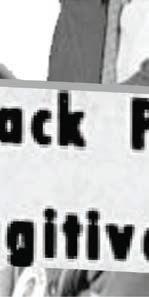

Between 1969-1971, the newspaper published approximately 170 articles that referenced the Black Panther Party. Nearly all of
In our newspaper this week, you’ll see an article about the Golden Transcript. It’s one of two dozen newspapers owned by Colorado Community Media, which also owns this paper. The article tackles the issue of systemic racism in the Transcript’s pages.

The idea for the project started in 2020, when the Colorado News Collaborative, Colorado Media Project and Free Press convened the Black Voices Working Group, which was made up of Black leaders, community members and journalists. The group addressed media coverage and focused on how to improve trust in mainstream media among the Black community. Acknowledging past harm was the No. 1 recommendation made by the group.

A few months later, I attended a Denver Press Club event where Jameka Lewis, a senior librarian at the BlairCaldwell African American Research Library, illustrated biases in mainstream local media coverage of the Black Panther Party in the 1960s and ’70s while exhibiting rare prints of the Black Panther Press. Many of Lewis’ examples came from the Transcript. Most articles were wire stories from
other cities, but editors still chose to run them, affecting perceptions of the party in Golden.
We pursued and were awarded a grant from the nonpartisan Colorado Media Project to explore, uncover and analyze this issue in the form of the special report that is in this edition of your newspaper.
Our newsroom, which is predominantly White, also participated in the Maynard Institute’s diversity, equity and inclusion Fault Lines training along the way. West metro editor Kristen Fiore was a speaker at the Advancing Equity in Local News convening with journalists from publications like the Philadelphia Inquirer and the Washington Post to talk about this project.
We believe this story is important beyond Golden — and we hope to spark conversations in our communities across the Denver area about race and inclusion and how our news coverage impacts those issues.
Linda Carpio Shapley is publisher of Colorado Community Media, which runs two dozen weekly and monthly publications in eight counties. She can be reached at lshapley@coloradocommunitymedia.com

these articles presented the group in a negative light, with words such as “fugitive,” “thugs” and “militants.”
And, the Transcript appeared to rarely cover the Black community in the city and wider region. Because of this, their voices are missing in archives, now online as an important chronicling of Colorado’s history.
By not including these voices in an accurate light, and by publishing stories that reinforced harmful stereotypes and/or recorded Black people’s traumatic experiences in an apathetic or ippant way, the Golden Transcript’s coverage contributed to systemic racism, according to researchers and Black community leaders.
Jameka Lewis, senior librarian at the Denver Public Library’s Blair-Caldwell African American Research Library and a freelance researcher on this report, said Transcript readers may have had their beliefs about the Black Panther Party, and the Black community in general, shaped by the Transcript’s negative portrayals.
“ ere is harm when it comes to media and the Black community in Denver and Colorado,” Lewis said. “If we want to repair the harms, we have to acknowledge that (they are) factual.”
Alfonzo Porter, editor-in-chief at Denver Urban Spectrum and a journalism professor at Metropolitan State University of Denver, said mass media has been at the epicenter of “propagating
How national, Denver-area papers covered the party Sisters Ida Daniel, Pat Rogers and JoEllen Greenwood grew up in Denver and graduated from East High School in the ’60s and early ’70s. ey recalled reading e Denver Post and Rocky Mountain News and watching the nightly news on TV. ey also listened to the city’s Black radio station, KDKO, and read Black-oriented magazines like Ebony and Jet.
Overall, the three didn’t recall a lot of news stories about Black people in the mainstream press, unless it was negative. e news covered Black people who were arrested for murder, robbery, rioting and other crimes. Rogers summarized the coverage as: “Be afraid of Black people.”
at kind of coverage played out with the Black Panthers. In 2016, e New York Times analyzed stories about the Panthers, noting “journalists were at once fascinated and frightened by them” and their activities in the 1960s and ‘70s.
Coverage about the Denver Panthers in Black newspapers in the area at the time was scant. Of those Lewis researched, the Black-owned publication e Denver Blade published the most articles on the group’s activities, both locally and nationally, in 1969.
Its coverage appears to be fairly balanced, Lewis said.
One Blade article discussed the Panthers’ organizing a meeting to discuss policing and police presence at Cole Jr. High School in Denver’s diverse Whittier neighborhood. It chronicled the Black community’s e orts to address a racial gap between teachers and Black students. One possible solution, and likely at the suggestion of the Denver Black Panthers, was to establish Cole as a Freedom School, a concept that focused on Black pride and Black liberation in academics.
In contrast, the Denver Post also covered the meeting but didn’t mention the Panthers’ involvement in organizing the event or the Freedom School proposal. In a review of Post archives, the story focused on arrests. e Denver Blade coverage did not mention any Black Panther arrests.
“Oftentimes, it was up to Black news media to cover this group in a more comprehensive way, which I believe e Denver Blade did,” Lewis said. “It covered all aspects of the local and national Panthers, and o ered readers a more balanced view of the members of this group.”
negative images and re ections of the AfricanAmerican community.”
“It really stems out of our country’s background, and we’re still dealing with those biases,” he said.







While almost all of the Transcript’s stories about the Black Panther Party were from wire services like United Press International, Porter said the Transcript and other newspapers are accountable for reprinting those stories.
“It’s exactly like original reporting, because … the editorial sta sat in a room, looked at this piece, determined that it was appropriate and ran with it in the paper,” he said.




The Black Panther Party
e Black Panther Party for Self Defense started in 1966 in Oakland, California. Founders Huey P. Newton and Bobby Seale started the organization as a response to police brutality there and in other Black communities, according to Lewis’ research.
e party had a 10-point program that included demands for Black liberation and societal improvement. Eventually, the Black Panthers led more than 35 community programs across the country, like the Free Breakfast for School Children Program — also known as e Free People’s Food Program, which helped feed Black children from economically disadvantaged families.
In Denver, a chapter gained recognition in 1967. Led by Lauren Watson, the chapter’s history was largely erased or ignored, Lewis said, adding that the Denver Panthers were instrumental in the ght for civil rights in Colorado.

e Denver Blade stopped operating in 1970. How Golden’s newspapers covered the Panthers
e Transcript published approximately 170 articles that used the terms “Black Panther” or “Black Panthers” between 1969-1971. Almost all of these were reprinted stories from wire services, which seldom described anything positive about the party or its members.
e only article referencing the party’s free breakfast program was published April 30, 1970, about Baltimore police rounding up Black Panthers suspected of killing a patrolman. After searching party headquarters, police searched a school where it conducted its breakfast program, among other locations.
In contrast, the Colorado School of Mines student paper, e Oredigger, published at least two stories about the Black Panther Party. Both were straightforward accounts of Lauren Watson, the head of the Denver chapter, visiting Golden.
Ultimately, while coverage of the Black Panthers varied by publication, the Golden Transcript failed to cover the party’s community initiatives or involvement. It did, however, print dozens of wire stories about the party’s supposed criminal activity and police raids associated with the group.
e coverage used negative language to describe the Panthers, their neighborhoods and any activities they were involved in. Because of this, Golden-area residents absorbed and believed what they heard and saw in the news coverage, Lewis stated.
e role of the press in forwarding racial inequality really shouldn’t be a surprise to anyone, Keesee said, especially to communities of color.
“It’s not just that person that wrote the story, that person had an editor, right? ere wasn’t anything in that editor’s mind that said, ‘Yeah… this seems a little biased. Did you even go into the community, or did you just take that o the wire and repeat it?’”
ere’s no excuse for sloppy journalism, as it is harmful and contributes directly to a larger narrative, Keesee said.
“When you talk about media coverage, there were only three channels on the television, back then; there was no social media,” she said, adding, “the newspapers were cranking out those stories overnight and you were waiting for your morning paper. Nobody was up waiting for breaking news. So, the news that was coming out, it was more focused and easier to control.”
It’s important to note that many Black community members both then and now have mixed feelings about the Panthers and their work, Lewis stressed.
Longtime Denver residents she interviewed formed their opinions largely based on what they read about the Black Panthers in newspapers and saw on TV. Yet that coverage contrasts with what many in the community saw the Denver Black Panthers doing. ey were involved in school board and City Council meetings, provided free meals for children, and worked to improve the welfare of their neighborhoods and its residents.
“Many Black people believed what the media said about the Panthers,” said Terry Nelson, a lifelong member of the Denver community. “ … It depended on the source. We recognized that the newspapers weren’t telling the truth about the members. … We knew that the Denver members were active in schools, speaking with teachers and parents. We never saw that in the major newspapers.”
Tracie Keesee, a former Denver police captain and co-founder of the Center for Policing Equity, described how during this tumultuous period, the press played into the hands of government o cials.
Newsrooms considered police as trustworthy and well-respected sources, so it was easy for them to hand reporters a story and have it taken at face value, Keesee said.
Keesee added: “We see it now, right? at divisiveness in the media, the stories that are being told — or not being told.”

And when news was breaking, “it was breaking only one way, and those narratives were pretty narrow,” she added.
During this timeframe, the Transcript was a daily paper with a small sta of six and a wire service that provided regional and national news.
Neil Paulson, who was managing editor from 1970-75, said the paper relied on United Press International reports to cover many issues, including the Black Panthers.
“It was a terrible service, especially for a small paper,” he said. “It cost us a little more, but eventually we went to e Associated Press.” e only dictate from the paper’s owners, e Kansas City Star and the Great (Kansas) Tribune, was to run a local story on the front page, Paulson said. National and regional stories ran inside.
Paulson noted that Golden’s population at the time, as it is today, was predominantly White.
He knew two Black Goldenites during his years as editor. One was Monroe Jordan, an assistant chef at downtown Golden’s historic Holland House, who later worked at the nearby Ace-Hi Tavern.
When Jordan died, Paulson ran a story on the front page that brie y memorialized him but mostly discussed an attempt to nd his relatives, as no one had come forward to claim Jordan’s body nearly two weeks after his death. Readers didn’t react positively to the
Golden in the 1960s and ’70s Built on lands traditionally inhabited by the Cheyenne, Arapaho, Ute and other tribes, Golden City was founded in 1859. According to Allan Tellis, a doctoral student of political science at the University of Colorado-Boulder and freelance researcher on this report, Golden has never had a signi cant Black population.
Census data from 1960 shows that the Golden division of Je erson County had 28 Black residents. By 1970, that number had increased to 86. Overall, those numbers represent 0.15% and 0.27% of the total population, respectively, according to Tellis.
As of 2020, Golden had 388 Black residents, representing 1.9% of the city’s population.
Longtime Golden residents recalled how many of the city’s Black residents in the late 1960s and early ’70s were associated with Colorado School of Mines as students, professors or their family members. As far as discussions about the Black Panther Party speci cally or race relations in general, longtime White residents said the topic didn’t come up much because there wasn’t a large Black population in the area.
Rick Gardner, a resident who has studied Golden’s history extensively, said the community had “other preoccupations at the time,” such as
In the community
While growing up in Denver in the ‘60s and ‘70s, Daniel and her sisters used their education and life experiences to help them decipher which news stories were biased and which were reputable. ey also relied on family and friends’ advice.
“I don’t think news at the time covered Blacks in the world that they lived in,” Daniel said. “To me, the general stories about how Blacks lived, what they did, what their concerns were and some of their needs, were not covered.”
e sisters felt this trend in coverage didn’t change until the ’80s, when news about Black people and Black communities became more prominent.
As an example, Daniel described how e Denver Post did a feature article on her late husband, Wiley Y. Daniel, who was a prominent attorney and the state’s rst Black U.S. district court judge. She also recalled how e Post’s society section ran pictures of positive stories happening in the Black community.
“I do think it began to change in the ’80s,” Daniel continued.
“ ere were positive stories (but)
front-page piece.
“I got a couple of nasty phone calls, but no one admitted to their bias,” Paulson said. “ ey refused to apologize, of course. ey said I shouldn’t have put that on the front page. In typical Golden fashion, there was nothing speci c, other than to say, ‘You shouldn’t have done that.’ e thought of another race didn’t exist.”
For the Transcript’s newsroom, Paulson said there was no “codi ed policy on racism” during his time
labor clashes at the Coors brewery and the Vietnam War.
John Akal, a longtime Goldenite and current columnist for the Transcript, described how he spent his summers in Chicago, where it was “a whole di erent situation.” Because of the 1968 Chicago riots, which were sparked by the assassination of the Rev. Martin Luther King, Jr., Akal remembered a lot of racial tension in the city at the time. But that was Chicago. Golden was di erent, but not necessarily better.
The KKK in Golden
Overt discrimination in Golden against Black people and other communities peaked with the Ku Klux Klan, which had a strong presence in the city and throughout Colorado, particularly in the 1920s.
e Klan began in Denver in 1921 and eventually “all but took possession of the state of Colorado,” according to a report in the Steamboat Pilot. Klan members throughout Denver gathered on Golden’s South Table Mountain for cross-burnings and other rituals. According to Golden History, the mountain could attract up to 10,000 members.
Overall, the Klan helped prevent or deter unknown numbers of Black people from carving out lives in the area. History Colorado recently released ledgers of KKK membership that show seven members of the terrorist organization resided in the
… the stereotypes were still going on.”
Diversity in the newsroom also seemed to improve during this timeframe, the sisters said. ey recalled Reynelda Muse, the rst Black person to anchor a newscast in Colorado, and Bertha Lynn, who started in Denver television in 1976.
While a lot has changed in how traditional outlets cover Black people and Black communities, the sisters believe there’s still plenty of bias. Rogers admitted that she avoids local news because there are still more negative stories about Black people than positive ones.

“I think there absolutely still is biased coverage,” she said. “I don’t want, every day, to hear about, ‘there’s another Black person who got in trouble.’”
In the country
Going back through American history, the Urban Spectrum’s Porter described other incidents where media outlets didn’t give Black people the bene t of the doubt. He listed the 1921 Tulsa Race Massacre and the Emmitt Till lynching as examples of the media portraying those involved as “guilty until proven innocent,” adding how
there.
“We condemned it, but we made little e ort to actively attack it,” he said. “( e) Black Panthers seem remote from Golden, where there were few Black families.”
One place where Paulson thought racism showed up was on the editorial page. e paper had four syndicated columnists every day who lived outside the community. ey were selected by the publisher because “they were cheap and not already
Golden area, Tellis added.
Racist housing policies, practices
While the Klan’s activities are certainly one reason Golden has a small Black population, it’s not the only reason. Discriminatory housing practices also contributed.
Don Cameron, a former Je erson County teacher and current Golden city councilor, has researched zoning history and discriminatory housing policies and practices, including some accounts recorded in the Transcript.
While many Black residents in Denver were constricted by redlining, their counterparts in Golden faced other challenges.
“Starting in the ’20s and into the ’40s, it was common for people to say that they would only sell their individual property to those of the Caucasian race, or non-Negro race individuals,” Cameron stated in a self-published article about Golden’s zoning history.
“ e courts backed up this right because they were protecting the homeowners’ use of their land and had no civic duty to prevent this discrimination,” the article continues. “Blacks were excluded from being shown properties in these restrictive neighborhoods, and if they tried to purchase them, (they) might have it taken away soon after.”
Perhaps the most evident example of this was in 1942, when Logus Butler and Susie A. Allison paid
being published by the two Denver dailies,” he stated.
Paulson said he had no doubt the paper could be accused of racism for its coverage in those days.
“But I’d like to think it was by omission rather than intent,” he said. “We rarely spoke of racism and did little to come out against its pernicious e ects. I don’t remember anyone on the sta making racist remarks, and I think I would have remembered that.”
$1,500 for 30 acres near present-day Boyd Street in north Golden. ey planned to build on it, but they were forced to sell a few months later after Golden residents drove them out.
“A large number of citizens appeared before the City Council Wednesday evening,” the Transcript reported Oct. 22, 1942, “and stated that a group of colored people had taken possession of the land recently purchased by them east of the Clark’s Garden addition, within the city limits of Golden, and were apparently staking out some building sites.”
After Butler and Allison were forced to sell the land, plots on the same land were listed for sale two years later. Ownership was restricted to “members of the Caucasian race.” ese accounts are just glimpses of Golden’s treatment of people of color, but Tellis emphasized how they demonstrate “institutionalized anti-Black behaviors and norms” in the area. So, he said, it’s no surprise that the Black Panther Party, an organization that “unapologetically called for Black liberation and the dismantling of White supremacist power structures, would catch the ire of local reporting.”
Tellis added: “Golden has displayed a deep commitment to the marginalization of Black people. To re ect on this legacy is pivotal if we desire to not replicate the racial strife and injustice of our past.”
the trend has persisted into today’s coverage of police shootings and similar incidents.
“And it seems as though that men-
our community,” he said. “And so, it’s always the bad news. ere’s really never any positive re ections.”
Regarding news coverage of the Black Panther Party, the journalism
For Goldenites
In more recent years, especially in the wake of George Floyd’s murder and the Black Lives Matter rallies in summer 2020, the Golden community has started examining the long reach of systemic racism in and around the city. e City of Golden started work on its Racial Equity, Diversity and Inclusion Action Plan, and groups like Golden United and Golden Anti-Racism Collective formed.
While these are good rst steps, real change has to start with people’s attitudes, GAC members Scrable and Michele Minihane said.
Although many Goldenites are open-minded and inclusive, Minihane personally believed there are still some residents who “do not value an integrated community and don’t feel like it’s important to make people of color feel welcome.”
She added: “I don’t get the sense that (attitudes) have changed a lot in 40 or 50 years.”
Scrable agreed that tangible changes, whether in attitudes or policies, have been slow. He said it’s going to take time and everyone working together to make Golden a more welcoming and inclusive place.
e two described how the Golden Anti-Racism Collective has become a place where people can share their experiences, examine systemic racism’s impact on the community, and nd ways to improve Golden for current and future generations.
As of last month, GAC has about 400 members on an email list and a few dozen who come to its regular meetings. ere are several subgroups within the Golden Anti-Racism Collective that tackle di erent topics such as policy and policing, education, and books and media.
While the bulk of the members are White, any Goldenites of color are welcome to join and participate as they’re able, the members said.
e group has established a unique partnership with the Golden Police Department, as some of its members sit on the department’s community engagement group, GAC member Sandra Knecht explained.
GAC and other community members have given feedback on various department policies, particularly around use of force.
GAC members also try to comment on City Council discussions and participate in other local matters, including education, youth outreach and a ordable housing. In doing so, the group has developed partnerships with Shelton Elementary, the Golden Library, Colorado School of Mines student groups, Golden United and other groups that share GAC’s goals.
Similar to GAC, Golden United formed after the 2016 election as “there was a fair amount of division, nationally and locally,” Ronnie
professor described it as a peaceful organization that was responding to violence “against African-American people in an attempt to say, ‘We will protect our community.’”
“ e idea was that Black folks with guns clearly scared the hell out of people,” Porter continued. “Because obviously, if you’ve got a gun, then you’re going to be violent. And it’s
Rosenbaum said. e group sought to bring people together and encourage respect for those who have di erent ideas and opinions.
Rosenbaum, who’s vice president on Golden United’s board of directors, described the partnership between Golden United and GAC, saying the two groups and others joined forces for a rally in summer 2020 and pushed City Council to approve the “Golden Stands with Black Lives” banner on Washington Avenue.
Minihane stressed how the GAC believes systemic racism impacts all Golden residents, regardless of race, and recommended locals read “ e Sum of Us” by Heather McGhee to learn more about that impact.
In summer 2020, the Golden City Council produced a series of resolutions meant to address its history of racial exclusion and racist domination of non-White groups, Tellis stated.
ese resolutions included:
• Resolution 2736 – Declaring Racism a Public Health Crisis
• Resolution 2747 - Declaring Support for Black Lives and Racial Equity rough a Public Display, and
• Resolution 2748 - Declaring A Commitment to Anti-Racism Actions
• Resolution 2736 states, “the Golden City Council recognizes that racial inequities have become institutionalized in the policies and practices of many agencies, governmental and otherwise. Council recognizes the need to examine seemingly neutral policies and practices to determine whether they are contributing to inequity and, where needed, change or eliminate the policy or practice as cities have a long history of decision and policy making that have resulted in classist and racist outcomes.”
Building on that, the city hired a consultant in June 2021 to develop a Racial Equity, Diversity and Inclusion Action Plan based on community input. After developing it for more than a year, the plan outlined four goals:
• Create a culture of inclusion and belonging throughout the community of Golden;
• Increase access to services and resources for diverse community members;
• Foster an organizational culture and environment within the City of Golden that’s committed to racial equity, diversity and inclusion; and
• Expand economic opportunities for diverse businesses.
Along with the REDI Action Plan, the consultants also recommended dozens of strategies toward these goals and an implementation plan.
For instance, public documents and other information should be available to those who don’t speak English or have di erent abilities. City boards and commissions should have a more inclusive recruiting process to ensure diversity among
only that mentality because of our profession (as journalists). Our profession has continued to promote that re ection — still does, to this day.”
As for Golden and the Transcript’s coverage of the Black community, Porter believed it likely made Black residents feel unsafe and unwelcome, saying, “ ey know that any
their members. e city also should host training about Golden’s history, structural racism and implicit bias.
City Council adopted the REDI Action Plan in December 2022 and called on the community to ensure Golden achieves the four goals in a timely, e ective way.
e plan was developed with race as the leading element because of how widespread and damaging racial inequalities are in the United States, according to city consultants. However, the REDI Action Plan is overall intersectional, examining how to make Golden a better place for people of all ages, abilities, gender identities, sexual orientations, socioeconomic backgrounds, religions and other demographics.
O cials said the next step is to assemble an implementation team of community members and city sta ers to make recommendations to City Council on how to achieve goals. Golden expects to assemble the team this spring.
In a Feb. 10 email, Mayor Laura Weinberg highlighted city o cials and community members’ ongoing work to “live up to our value as a welcoming and inclusive city.”
“I applaud the Golden Transcript’s work to identify its role in racial inequities in the past and its role in systemic racism,” she stated. “ e City of Golden has undertaken similar work … (and) I look forward to this year’s actions to take the information from our new REDI plan and put community-driven solutions into practice.”
For the Golden Transcript
While the Transcript’s ownership and newsroom has changed greatly since the late 1960s and early ‘70s, it’s not immune from the biases and attitudes that riddled its past coverage and contributed to systemic racism in and around Golden.
Scrable said reading the Transcript’s past coverage of the Black community can be “demoralizing,” but even recent stories have failed to represent Black voices accurately.
He pointed to an Aug. 31, 2020 Transcript story about City Council’s decision to display a “Golden Stands With Black Lives” banner over Washington Avenue. e story said the banner would be displayed for 60 days, “an amount of time intended to symbolize how long it took for slave ships to cross the Atlantic.”
Scrable and his GAC co-chairs did advocate for 60 days, but he said they never assigned any symbolism or signi cance to the number.
“It might’ve been said (in the meeting), but it wasn’t us,” Scrable said of GAC.
During the 2020 meeting, Councilmember Bill Fisher stated that he wanted the banner to be up for a period of time that was “meaningful” and mentioned that 60 days would be a meaningful period because it would represent the general length of that crossing. He did not say who
coverage of them will not be balanced and fair.”
Fairness and racial equity are concepts Golden, Denver, the United States and journalism as a profession need to work on, he stated.
“I don’t see our profession doing enough work in that area,” Porter said. “I hear the talk. But I’m not seeing anything to back it up.”
had rst suggested that symbolism or if it was his own suggestion.
After the story, Scrable received about 20 phone calls from people upset about the supposed symbolism. He felt the Transcript missed an important detail about the timeframe and that it was insensitive, creating a frustrating experience.
He wanted the Transcript to ensure there are positive stories about people from historically marginalized groups, and do better educating Goldenites about their neighbors’ achievements and experiences.
Scrable added: “I’m looking to the Transcript to paint a positive picture for all people of color … and representing ‘all’ versus ‘a few.’”
e Colorado Community Media newsroom acknowledges it has work to do, and this February 2023 report is only the rst step in what the team hopes will open a wider conversation about systemic racism and media coverage for years to come. Working on this report brought CCM sta members face-to-face with outdated practices and implicit biases.
Going forward, CCM’s goal is to include more voices of color in the newsroom and on the pages of its two dozen publications, Publisher Linda Shapley said. CCM wants to ensure all local voices are heard and included, while also re ecting on racial equity, diversity and inclusion. CCM will strive to consider the lenses through which the sta decides to cover stories in the rst place. Appreciating di erences in CCM’s coverage areas, like history and culture, will guide the newsroom in its e orts.
Other newspapers such as the New York Times, the Washington Post, e Kansas City Star, Philadelphia Inquirer and more have done similar analyses of their past coverage, and the Transcript encourages other newspapers in the region and across the country to do so as well, Shapley said, adding that it wouldn’t have been possible without a Colorado Media Project grant.
For all journalists, Porter stressed the importance of continuing to diversify newsrooms and ensuring fair, balanced and objective coverage and “stop convicting people without evidence.”
He called on more publications to review their past coverage and acknowledge its harmful impacts, saying it’s important to shine a light on the truth, to be honest and to be transparent.
“If we’re ever going to get past this, it’s going to take some truth-telling,” he said. “It will be hard. It will be di cult. But it really is one of the last vestiges to make this country what it said it was in the beginning — freedom and liberty for all. Which has not been the case for us.”
Jameka Lewis, Allan Tellis, Kristen Fiore, Rylee Dunn, Christy Steadman, Steve Smith and Deborah Grigsby contributed to this report. Greg Moore contributed as an editor.
e multitalented Natalia Roberts is about halfway through her Visiting Artist of Color Residency conducted by the Art Students League of Denver. Roberts brought a wealth of talent to the position: performer, choreographer, lmmaker, photographer and teacher. And she also studied architecture.
rough her work, Roberts “aims to tell the stories of those who are often overlooked, and let these overlooked subjects know that their beauty, physicality and potential are seen,” states a news release.
e ASLD opened in 1987, with artists teaching 100 students that rst year and pushing them to reach their potential. Today, the league operates from the Sherman School at 200 Grant St. in the Speer/West Washington Park area. More than 14,000 students attend its classes, workshops,
To learn more about the Art Students League of Denver, visit asld.org.





To register for Natalia Roberts’ master class in photography, “Photography Abstraction, Surrealism and Storytelling with the Human Form,” visit tinyurl.com/ ASLD-RobertsMasterClass.
teen studios and summer camps.
ASLD’s Visiting Artist Series got started in 2003. e BIPOC focus was added in 2021 with Kevin Snipes, a ceramicist who wants to combat the inequity of opportunities for artists of color and thereby enrich the Denver arts scene.
“We started this residency as an acknowledgement geared to BIPOC, starting with the idea that the art world is harder to access because of racism,” said Tessa Crisman, communications manager at ASLD. “So we wanted to make this program to provide resources to artists who might be given those resources, and to connect
our community and di erent voices than those that teach every day.”
Roberts is the second person to ll the position. She is originally from Detroit and was living in San Francisco when she learned about the Denver residency, which includes housing and nancial support.
“I was a little hesitant because I didn’t know anything about Denver or the Denver art scene,” she said. But “I was particularly attracted to this organization because I had been working as a professional dancer in New York City.”
An injury halted her dancing for about eight months. She found a New York organization that was similar to ASLD and took classes in photography subjects such as how to shoot and edit.

ASLD’s selection process includes a panel of community members who assess applicants on the quality of





Anyone who has seen a child fall in love with music knows the lasting impact the art can have on a life. But if children never have access to those instruments, all the love of music in the world won’t do any good.
For the last 13 years, Steve Blatt,
executive director of the Bringing Music to Life Instrument Drive, has been working to ensure that students all over the state have instruments to play. And his passion for the cause is just as strong as ever.
“In some ways, we’re just trying to do a better job of what we’ve always done — reach more schools and get more instruments out,” he said. “ is
is the kind of thing that takes the help of a lot of people to make happen and we’ve always had very generous partners all over the state.”
And while this year’s drive will be Blatt’s last year as the nonpro t’s executive director, he’s remaining on the board. e newly appointed assistant executive director, Christine Andresen, will be taking over and can
match Blatt’s dedication to providing the lifelong gift of music.
“ ere are so many children struggling and people may not know what to do or how to help,” Blatt said.
“What’s great about this is it’s a concrete way to have a positive impact on a child’s life.”
their work, how their work ts in with media currently o ered at ASLD, and the clarity of their plans for both community engagement and personal growth as an artist throughout the residency, Crisman said.
“Natalia was chosen for her mastery of dance and photography, as well as her excitement around building artistic community as a new Denverite,” Crisman added.
Roberts moved to Denver in early 2022. She divides her time several ways, including having open studio events, teen and adult photographing workshops, and preparing an exhibi-
FROM PAGE 14
Since the drives began, more than 7,500 instruments have been awarded and the organization estimates that more than 18,000 students have bene ted from the years of donations.
e 2023 Bringing Music to Life Instrument Drive is running from March 6 through March 19. Participants who have gently-used band and orchestra instruments they no longer play can be taken to any one of 16 donation locations across the state.
All types of band and orchestra instruments are welcome, but tubas, baritones, tenor saxophones, string basses, cellos and violas are all especially needed.
tion scheduled for this summer. It is slated to open mid-June and run through the end of July, when the residency ends.
roughout her work, Roberts tells the stories of people often overlooked, and lets “these overlooked subjects know that their beauty, physicality and potential are seen,” ASLD said in a news release.
e teen workshop Roberts instructed including her teaching the students the basics of photography, such as lighting and how to direct models during photo shoots. It showed Roberts that “there’s a learning curve for me in teaching teenagers photography,” she said. “By the end of the last couple of classes, I let them make choices for themselves. ey did some really amazing
For donations: Visit bringingmusictolife.org. There is a map with all the statewide locations, with the Denver locations being:
• Kolacny Music, 1900 S. Broadway (Platt Park/Overland)
• Twist & Shout Records, 2508 E. Colfax Ave. (Congress Park/City Park)
• Luther Strings, 2018 S. Pontiac Way (Virginia Village)
e organization understands that donating what was once an important part of a life can be di cult.
“It can take a bit of time for people to get ready to give up an instrument,” Blatt said. “You remember all the pieces played and the concerts you performed. It’s more than just a piece of wood or metal — it’s a meaningful
things.”
e residency is twofold, giving Roberts her own studio space where she can photograph models for projects.
Roberts also has a duty to promote community engagement.
“She’s been o ering tours of the studio to her audience,” Crisman said. “ ey can ask about her creative process.”
Roberts will conduct a master class in photography for adults titled “Photography Abstraction, Surrealism and Storytelling with the Human Form.” It’s scheduled for March 11-12.
Roberts said the best thing about the residency is getting her own, dedicated workspace.
“It’s all pretty amazing,” she said. “In photography, you are constantly
having to rent space and manipulate it, or set up a space in your kitchen, or bathroom or backyard. It’s always a hurried situation. ere’s a lot of negotiating with other people.”
She cited another bene t: “You don’t have to worry about breaking it down and setting it up for the next shoot. You have more energy to spend on the craft of photography.” is experience has given Roberts the freedom to work on and develop her own style more deeply, she said.
“So much of art-making now, you have to make it quick, (and) you have to make it cheap in order to make a living,” Roberts said. “Perhaps more than anything else, it enables us to play and make bad art, (and) learn how to make it good art. Without getting to experiment, you can’t grow.”
The website also has information on how to donate to the repair fund.
For Schools: Schools that have a majority of students receiving free or reduced cost lunches should apply for instruments through March 31 using the online application form. The organization will match qualifying schools with donated instruments.
instrument to them.”
ose who want to support the organization but don’t have an instrument can contribute by donating to the repair fund. All this money goes to the expensive process of repairing and refurbishing donated instruments so they’ll be ready to go for the students who will use them.
Bringing Music to Life works with Rocky Mountain Music Repair, Luther Strings, Denver Percussion and Monkton Guitars for repairs. e 2022 drive provided 684 donated instruments to 45 music programs across the state and there are stories connected with so many of the instruments - stories that can be seen on the cases the instruments are donated in. ere are stickers from travels around the country and some people include notes for the new musician that the organization ensures to pass along.
“I am not a musician, but I have experienced the fun, pride in accomplishment and sense of belonging to a creative community which their notes describe,” Andresen said, quoted on the Bringing Music to Life website. “ ere is not a downside to participating in this.”
e annual lm festival put on by Denver’s Jewish Community Center is for everyone. is is something that Richard Cowden wants to stress. e Denver Jewish Film Festival is open to everybody, not just Jewish people.

“We want to attract more non-Jews,” said Cowden, general manager of the Mizel Arts and Culture Center at the Staenberg-Loup Jewish Community Center. “We’d love to have people from other cultures want to come in and see lms that are by Jewish people or about a topic from Jewish history or current a airs.”
e 27th annual Denver Jewish Film Festival takes place March 11-19 at the JCC Mizel Arts and Culture Center, 350 S. Dahlia St. in Denver. A streaming on demand option for the festival will be available from March 20-29.




Independent lms are growing. is year, the festival received more than 300 submissions and is presenting about 40 lms from 14 countries, including full-features, nine shorts and one TV mini-series.
“It makes you realize that the lm world we see is just the tip of the iceberg relative to the amount of content that’s being presented every year,” said Cowden, who’s in his third year of working on the festival. “Ours is but a sliver of the lms that are made.”
Films go through a rigorous screening process, watched by a pre-screening committee, then a lm selection committee. And they watch a ton of lms before choosing the festival lineup, with submissions from all over the world.
“It’s surprising, the growth of lms by people in Israel and internationally, the amount of attention that is paid to Jewish














The 27th annual Denver Jewish Film Festival at the JCC Mizel Arts and Culture Center, 350 S. Dahlia St. in Denver, takes place March 11-19 in-person, and streaming on demand from March 20-29. Tickets are on sale now, and are available for individual screenings and all-access passes. For more information, visit jccdenver.org/film.
lms and stories,” Cowden said. “ ere’s a lot out there.”

Cowden mentioned a few of his favorites.
“Farewell Mr. Ha mann,” opens the festival at 8 p.m. on March 11. e lm is set in Paris in 1941 under German occupation. An employer, Mr. Ha mann, and his employee Francois “are forced to strike a deal which, over the following months, will upend the fate of all concerned,” states the printed program.
“Ha mann has been winning rave views and awards from festivals all around the world,” Cowden said.

Another is a Polish lm called “ e Wedding Day.” It takes place in contemporary times and involves the daughters of a meatpacking magnate. e lm splits into two realities, Cowden said. Some of it is presentday, some visits the dark past of this Polish village.
“ ere’s a lot of going back and a lot of ash forward. Eventually, they become one,” Cowden said. “If people are looking for something day, it’s really fascinating.”
Cowden also points out “ e Swimmer,” which takes place in a parallel reality, where a young Israeli competes for an Olympic spot.
“It’s very fascinating, especially in the category of gay lms,” Cowden said. “It’s an interesting lm because it’s not like a documentary about an Orthodox kid who realizes he’s gay. It’s got an ending that’s unforgettable.”












